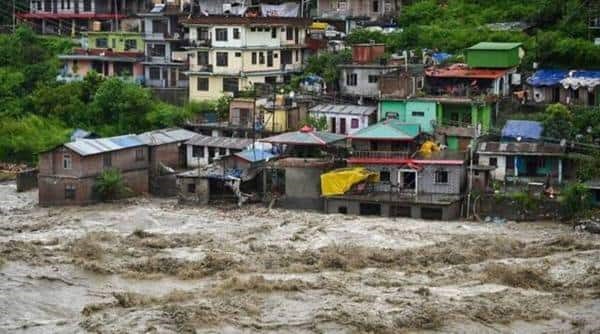Description

Disclaimer: Copyright infringement not intended.
Context
- How does the Centre determine the scale of assistance it provides to a state hit by a natural disaster?
- How is a severe calamity differentiated from a calamity?
Details
Why is Himachal Pradesh demanding assistance?
- Rain-related occurrences in Himachal Pradesh cost the state Rs 10,000 crore during monsoon. He urged that the incident be labeled a national disaster and that a special disaster relief package be announced.
- According to the state emergency operation center, 418 people have died (265 in rain-related incidents and 153 in road accidents) since the onset of monsoon on June 24 till September 9, while 39 are missing.

How are states assisted during natural disasters?
- There is no official or well-defined classification of "national disasters."
- The 2005 Disaster Management Act defines a "disaster" as "a catastrophe, mishap, calamity, or grave occurrence in any area, arising from natural or man-made causes, or by accident or negligence, resulting in substantial loss of life or human suffering, or damage to, and destruction of, property, or damage to, or degradation of, the environment, and is of such a nature or magnitude as to be beyond the coping capacity of the community."
- The Act established the National Disaster Management Authority (NDMA), which would be led by the Prime Minister, as well as State Disaster Management Authorities (SDMAs), which would be led by respective Chief Ministers.
- In India, an integrated Disaster Management setup was to be built in collaboration with district-level authorities.
- The Act also resulted in the formation of the National Disaster Response Force.
- It has many battalions or teams that are in charge of on-the-ground relief and rescue efforts in several states.
What is the NDRF?
- The 2005 Disaster Management Act mentions the National Disaster Relief Fund (NDRF).
- Similarly, SDRFs exist for states and are the major monies available to state governments for disaster relief.
- The Central Government contributes 75% in general states and 90% in northeastern and Himalayan states to the SDRF.
- The SDRF is only to be used to fund the costs of giving urgent relief to victims of registered disasters such as cyclones, droughts, earthquakes, fires, floods, tsunamis, hailstorms, landslides, avalanches, cloud bursts, pest attacks, and frost/cold waves.
- The National Disaster Management Authority stated in a November 2019 article that "the state government is primarily responsible for undertaking rescue, relief, and rehabilitation measures in the event of a disaster." However, these can be reinforced by central aid.
- "In the event of a severe calamity, where the need for funds for relief operations exceeds the funds available in the State's Disaster Response Fund account, additional Central assistance is provided from the National Disaster Response Fund, after following the laid down procedure," it states.
What exactly is a severe disaster?
- This classification is based on a unique method in which the state government must submit a memorandum detailing the sector-specific damage caused by a disaster and the cash required.
- Following that, an inter-ministerial central team is formed to conduct an on-the-spot assessment of damage and the need for finances for relief activities.
- After this, specific committees examine these assessments and submit their reports. A High-Level Committee must approve the quantum of immediate relief to be released from the NDRF.
- The Disaster Management Division of the Ministry of Home Affairs will then provide support and monitor the utilization of funds.
- A calamity is determined to be of "rare severity"/"severe nature" based on undefined criteria, however, elements such as the calamity's intensity and extent, the amount of aid required, and so on are considered.
- A Calamity Relief Fund (CRF) is established, with the corpus split 3:1 between the Centre and the states. When the CRF's resources are depleted, extra help from the Centre's National Calamity Contingency Fund (NCCF) is considered.
- Once a tragedy is labeled "severe," relief in loan repayment or the issuing of new loans on concessional terms to those impacted is considered.
- Otherwise, funds for the NDRF and SDRFs are granted by the government as part of budgetary allocations for preparedness, mitigation, and reconstruction.
- The Finance Commission - a constitutional authority that proposes the division of financial resources among the states and the Centre - recommends funds for immediate assistance for five years.

The 15th Finance Commission (for 2021-22 to 2025-26) Methodology
- The 15th Finance Commission (for 2021-22 to 2025-26) developed a new methodology for state-by-state allocations based on criteria such as previous expenditure, risk exposure (region and population) hazard, and state vulnerability.
- The commission has allocated Rs. 54,770 crore under the NDRF. It allotted a total of Rs. 1,28,122 crore in SDRF to all states, with the central government contributing Rs. 98,080 crore and the state government contributing Rs. 30,041 crore.
- The annual Central contribution is released in two equal installments as per the recommendation of the Finance Commission.
- These are released on the receipt of a Utilisation Certificate of the amount released in the earlier installment and the receipt of a report from the state government on the activities undertaken by SDRF.
- However, in July this year, these requirements were waived "given the urgency" during extreme rainfall in many states.
- In addition, an amount of Rs 32,030 crore has been allocated by the commission under the State Disaster Mitigation Fund (SDMF), which is for carrying out works such as restoration of forests, raising public awareness, etc., and Rs. 13,693 crore for the National Disaster Mitigation Fund (NDMF).
|
PRACTICE QUESTION
Natural disasters including floods, cyclones, and earthquakes are becoming more often and severe in India. Discuss the issues that the country faces in dealing with similar tragedies in this situation.
|
https://indianexpress.com/article/explained/explained-economics/nifty-at-20000-whats-driving-the-market-should-valuations-worry-investors-8935542/











